|
Graveyard at All Saints Church, Burton-Dassett, Warwickshire, England, where some of my husband’s ancestors are buried. |
Copyright © 2012 Linda Huesca Tully
|
Graveyard at All Saints Church, Burton-Dassett, Warwickshire, England, where some of my husband’s ancestors are buried. |
Copyright © 2012 Linda Huesca Tully
Gilbert Cayetano Huesca (1915 – 2009)
Joan Joyce (Schiavon) Huesca (1928 – 1987)
Copyright © 2012 Linda Huesca Tully
Joan Joyce (Schiavon) Huesca (1928 – 1987)
Gilbert Cayetano Huesca (1915 – 2009)
The most wonderful day of my life. Gil gave me an engagement ring this evening at home before we left with Mr. and Mrs. Waples to go to the Ivanhoe. We had dinner, danced, had our fortunes told and went down thru (sic) the “Catacombs.” Then, my darling Gil had some singers come to sing “Happy Birthday” to me. This evening will live in my heart forever as my love for Gil is for all my life.
I love him as I have never loved anyone before. For you, Gil dearest are in my every thought, action, and breath. May you always be as proud of me, as I am of you.
 |
|
My mother’s first diary entry, July 3, 1954. “My Secret Love,” she wrote at the top, “When we two are one” |
JULY Four (This was my mother’s 26th birthday)
How happy and proud I was to show everyone at Downer’s Grove my engagement ring, because I love you, my darling, with all my heart. It was wonderful meeting your brother Carlos*. He is very sweet. I do hope he will like me.
Mrs. Waples was so darling to make such a beautiful cake for my birthday. I was so thrilled and happy today. But, I know that I shall always be happy as long as you are with me.
Today I went shopping with you for the first time. I hope that in later years you will always take me with you, as such little things when shared together should keep us very close to one another.
We got caught in the rain and put your raincoat over our heads! I even enjoy the rain with you, my darling. I was so afraid you wouldn’t get a chance to kiss me goodnight when Dad and Mother took you home. But we did kiss and now I am happy.
Being with you tonight was wonderful, but Darling, you really gave me a scare when you said you had something to show me. You didn’t tell me it was your heart until after you unbuttoned your shirt. Then, I felt so silly because you told me I was blushing.
Mrs. Waples was so sweet to make that jar of cookies for me. Dearest, I am so proud to love you. I really am very fortunate to have you to love.
Your Mother was very sweet in her letter. I hope I will make a good wife to her son.
I wonder what you will think ten years from now when you read this?
I just finished talking to you on the telephone. The roses that you brought me this evening are beautiful. I have them here in my room so that I can look at them as I go to sleep and think of you and how much I love you, my Darling.
I hope you will get a nice rest tonight – you sounded so tired on the phone tonight. I’m getting sleepy, now dear, so goodnight for now. I love you.
What a lovely evening we’ve had tonight! It’s just a week now that we’ve been engaged. I’m so proud of my ring and of you.
Has any girl ever been as happy as I am. And darling you are what makes this little package of oatmeal so happy. It was so nice dancing at the “Sociedad Española.” (Is my Spanish improving?)
To be with you is always wonderful. I was very sorry that the Algarins did not come. But you were with me. That’s enough for me!
Copyright © 2012 Linda Huesca Tully
Gilbert Cayetano Huesca (1915 – 2009)
Joan Joyce (Schiavon) Huesca (1928 – 1987)
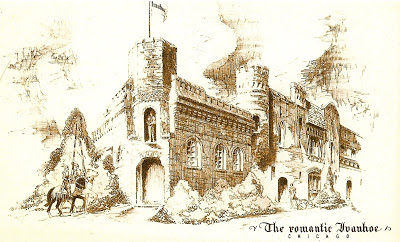 |
| A postcard of the Ivanhoe, a popular medieval-style Chicago restaurant, where my parents feted my mother’s 26th birthday and their engagement on July 3, 1954. |
It was a Saturday evening, and the good people of the City of Chicago had already begun their festivities for Independence Day, just hours away. Fireworks celebrating the American holiday were going off all over the city, but for two people who had just promised their undying love to each other, they seemed to be heralding the start of a beautiful life together.
Copyright © 2012 Linda Huesca Tully
Gilbert Cayetano Huesca (1915 – 2009)
Joan Joyce (Schiavon) Huesca (1928 – 1987)
When we kids wanted to hear a story, our parents, Gilbert and Joan (Schiavon) Huesca, often reminisced about their first date. It was one of our favorite stories. I heard it again one last time in 2009, months before my father died, as he shared his still vivid memories of that time.
 |
| The Schiavon home, 8200 South Saint Lawrence Avenue, Chicago, Illinois |
How could he say no to her? Off they would go, again and again, oblivious to the neighbors watching amusedly from their porches in the sticky Chicago heat, until the street lights on Saint Lawrence Avenue came on and my grandfather would look out the front window.
Copyright © 2012 Linda Huesca Tully
Gilbert Cayetano Huesca (1915 – 2009)
Joan Joyce (Schiavon) Huesca (1928 – 1987)
Alice (McGinnis) Schiavon (1895 – 1963)
Fern (Lawton) Waples (1899 – 1961)
“She’s too much girl for you.”
 |
| My father, Gilbert Huesca |
 |
| My mother, Joan Schiavon, with her parents, Alice (McGinnis) and Ralph Schiavon, Chicago, Illinois |
“25 – but you have to see my parents first.” She smiled back at him, slid off the stool, and went back to work.
And all this because my father had gone looking for a greeting card and came away with a priceless find in the lady he would soon ask to become his wife. For that I will be forever thankful.
* This restaurant may have been a place called “Flukies,” located at 8211 South Cottage Grove Avenue.
Copyright © 2012 Linda Huesca Tully
Gilbert Cayetano Huesca (1915 – 2009)
Frank Waples (1901 – 1993)
Fern (Lawton) Waples (1899 – 1961)
 |
| My darling father, Gilbert Huesca, at the home of Frank and Fern Waples, Chicago, Illinois. Circa 1952 – 1954. |
 |
| Frank and Fern Waples, dear friends of my father’s, at their home in Downer’s Grove, Illinois, Memorial Day, 1957 |
 |
| Gilbert Huesca, age 36, Chicago Illinois, January 20, 1952 |
Fern, a private school teacher, was charming and direct. She noticed how much my father missed his family and friends in Mexico and took him under her wing, helping him with his English and coaching him on American culture and customs. She was always encouraging him to meet new people and experience new things. My father recalled that Fern was a stylish dresser who rarely went anywhere without her trademark pearl necklace and earrings. She loved a good sale and was the person you went to when you wanted to know where to find that “something special.” This special knack of hers would one day change my father’s life.
From what he told us, the big house was usually bustling with young people – the grown-up Waples children and their friends. The family’s relaxed nature and constant activity made him feel right at home. When he wasn’t playing chess with Frank or testing Fern’s baking, he was taking one of their daughters to the museum or the movies.
I was only 6 years old when my father told me that Mrs. Waples, as we knew her, died. It was the first time I knew someone who had passed away. I recall my parents driving with my two sisters and me to the funeral home for the wake. (I couldn’t figure out why they called it that when we knew she would never wake up.)
The sky was overcast, and a light rain was falling. My father parked a short distance away from the funeral home. He and my mother took turns watching us while the other went inside to pay respects. They were very quiet all the way home.
Frank retired some time after that. He moved to San Marcos in Southern California and marred a second time to a lovely lady named Katie. They later moved to Arizona, where he died in 1993.
Copyright © 2012 Linda Huesca Tully
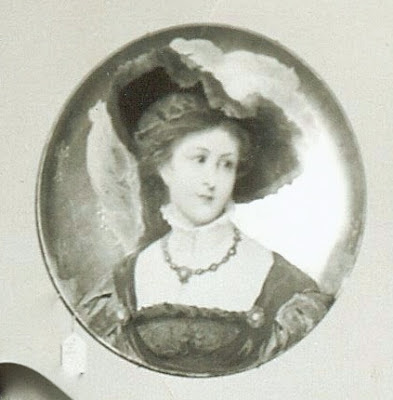 |
| The Lady Plate, signed by the artist Dapoigny and undated, was with us so long, she was practically a beloved member of our family. |
One of the most stunning pieces in the Chatham collection was the large porcelain plate pictured here. Measuring about 27 inches in diameter, it bore the likeness of an aristocratic lady dressed in vivid hues of burgundy, white, pink and blue, painted on a gold field with raised designs. The plate was signed “Dapoigny”on the bottom and was not dated.
The lady on the plate appears to be French. Beyond this, we know nothing of the plate’s provenance. This was one of the articles my grandmother and mother brought back from Europe, though I do not recall hearing where they found it.
The “Lady Plate,” as our family called it, hung in Chatham Galleries for a while. Like so many other things, she eventually made her way to my grandparent’s home, where she reigned in splendor for nearly a decade. Before my grandmother died in 1963, she gave the Lady Plate to my mother, knowing she would always cherish it.
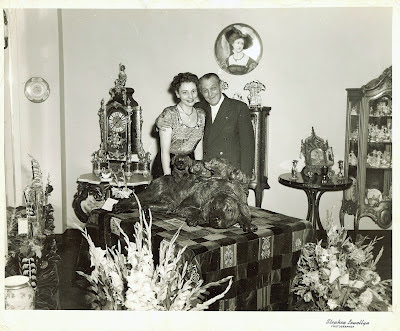 |
| My mother at Chatham Galleries, the antiques business she and my grandmother owned. The Lady Plate hangs behind her on the wall. The gentleman with my mother is unidentified. Chicago, Illinois, 1951. |
The Lady Plate became a special part of our family, and we accorded her the reverence and love as the grande dame she was.
She came with us when our family moved down to Mexico City and again a few years later when we moved to California, both times safely cradled in a bundle of blankets on my mother’s lap in the front seat of our yellow 1962 Ford Falcon station wagon. This was no small feat, considering the plate’s size and heaviness.
The Mexican roads were not the best, even the modern toll roads. My father did all he could to navigate around bumps and holes in the road, but this was not always possible over the 3,000 or so miles we covered. There were no seat belts in those days, so we were jolted back and forth and up and down as the car rounded sharp curves, dodged erratic drivers, or hit the inevitable surprise pothole. Through it all, my mother held tight to her treasured bundle.
Thanks to my parents’ diligence and care, the Lady Plate survived without a scratch. She seemed to graciously accept her new place of honor on the living room wall wherever we went, presiding over us with her peaceful countenance.
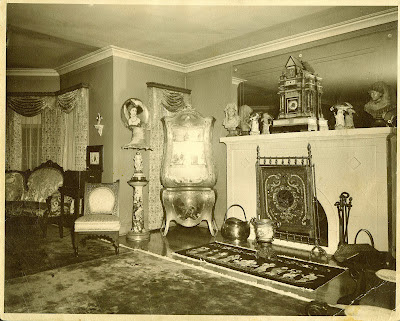 |
| The Lady Plate hung on the living room wall of my grandparents’ Chicago home, circa 1950 – 1959. |
My father, Gilbert Cayetano Huesca, always carefully anchored the Lady Plate to the wall to keep her intact and safe. Despite her vintage, which we guessed to be between 200 – 300 years, she never grew old but remained serenely beautiful, outlasting her many owners, including my grandmother and my mother.
She was there for us during the milestones of our lives: our first steps, birthday parties, graduations, marriages. She was there as we faced the loss of our mother to cancer and when we brought our newborn children home to visit their grandfather.
She seemed invincible all those years, surviving the jarring 7.1 Loma Prieta Earthquake that struck Northern California in 1989 and who knows what other calamities centuries before. Yet like many things of beauty, she could not last forever.
Her long life span finally came to an end one afternoon in 2008. My precious father, by then 92 years old and still strong and independent of body and mine, was deep cleaning his living room when he moved the couch away from the wall. Somehow he must have bumped into the Lady Plate, and she came crashing to the floor. Thank God he was not hurt.
Not knowing what had happened, I arrived at his apartment for lunch a short while later and found him sitting at the table with his head in his hands, a large plastic bag containing the pieces of the beloved plate by his side. He was overcome with grief. I think he felt as though he had lost a good friend who had been a part of his life for over fifty years. To him the Lady Plate represented my mother – his wife, the most beautiful and important Lady in his life and the owner of his heart. We held each other and cried.
It could have happened to any one of us. My dear father, the most careful and meticulous person I have ever known, was not at fault for the demise of the Lady Plate. Ever mindful of my mother’s love for this prized possession, he had cared for the plate for over two decades as one who had been given a priceless treasure to guard. Sometimes, though, things happen, no matter how hard we try to prevent them. Perhaps it was simply her time.
I have the Lady Plate now, carefully put away in her new form. A large part of her face is still intact, but the rest of the pieces were not so lucky. I just cannot bear to part with her, even in her fragments. Maybe some day I will be able to have someone put her back together so she can resume her place on our own living room wall to lovingly watch over and be cherished by future generations.
Copyright © 2012 Linda Huesca Tully
Alice Gaffney (McGinnis) Schiavon (1895 – 1963)
Joan Joyce (Schiavon) Huesca (1928 – 1987)
 |
| Invitation to and newspaper article about the grand opening of Chatham Galleries. Note that Schiavon is misspelled “Chiavon.” |
Her doll collection already took up considerable space in the family home at 8200 St. Lawrence Avenue.. A November 11, 1945 article in the Chicago Daily Tribune noted that the dolls took over the entire basement, at one time numbering 3,600. It was no surprise, then, that Alice needed more room to house her treasures.
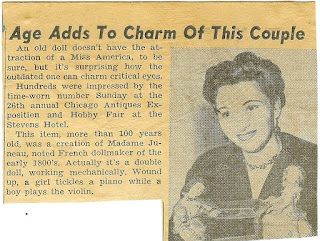 |
My mother holds a french antique couple from the early 1800s in this article on the Chicago Antiques Exposition and Hobby Fair, published in the Chicago Daily Tribune. |
When Alice and Joan returned from their European adventure in the fall of 1950, they set to work to plan their business, scouting locations, contacting vendors, evaluating inventory, and arranging displays. Nearly one full year later, on Saturday, September 29, 1951, they opened The Chatham Galleries at 8231 Cottage Grove Avenue, on Chicago’s South Side, stocking not only antiques but also fine art, gifts, and greeting cards.
Interestingly, the name of the building it occupied was the Aranoff Building – a slightly different spelling than that of Abraham Aronoff of New York, who had been a constant companion of my mother and grandmother’s during their recent tour of Europe.
 |
| My mother, Joan Schiavon (right), age 23 here, proudly greets her sister-in-law (and my godmother) Angelina (Ciliberto) Schiavon, just before the store’s grand opening. I do not know the identity of the young man in the center; could he be Angelina’s brother, Joe Ciliberto? |
My mother’s college friend, Margaret Yu, sent best wishes and hearty encouragement to the mother-daughter team. She recalled that in her own hometown of Hong Kong, the Chinese invited all their friends and family to visit on frequent occasions when they opened a new business.
Copyright © 2012 Linda Huesca Tully
Joan Joyce (Schiavon) Huesca (1928 – 1987)
Alice Gaffney (McGinnis) Schiavon (1895 – 1963)
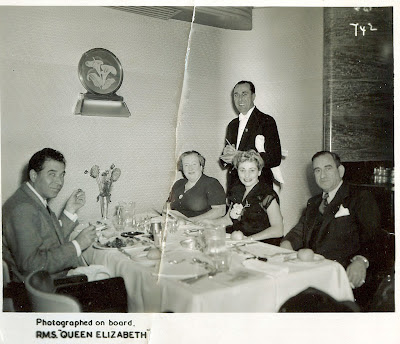 |
| “Mother and I in dining room with ‘Dreamboat,’ our waiter, October 3, 1950,” Joan Schiavon wrote on the back of this photograph, adding, “Very, very English, I say!” |
It had been an exciting trip, filled with fascinating people, new experiences, and places that seemed exotic to two midwestern women.
Other pieces, including some furnishings too big to carry home, would make their way to Chicago on container ship, intended for the new fine art and antique gallery my grandmother would open. Most of them, however, would eventually make their way to her home, where they would live quite happily with her and my grandfather, surrounding them with their history and graceful elegance for the rest of their lives.
Copyright © 2012 Linda Huesca Tully